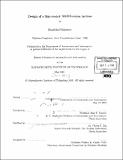Design of a film cooled MEMS micro turbine
Author(s)
Philippon, Baudoin (Baudoin Henry), 1975-
DownloadFull printable version (10.01Mb)
Alternative title
Design of a film cooled microelectromechanical systems micro turbine
Other Contributors
Massachusetts Institute of Technology. Dept. of Aeronautics and Astronautics.
Advisor
Alan H. Epstein.
Terms of use
Metadata
Show full item recordAbstract
As part of an effort to develop a portable power generation system, a fluid dynamics and thermal transfer investigation of a micro radial inflow turbine was carried out. The 3-D numerical performance assessment revealed that the baseline 2-D designed turbine stage was not matched to the baseline compressor, resulting in off design operation. The CFD predicts that the baseline turbine has a total to static efficiency of 29%, and does not provide enough power to drive the compressor at the matched pressure ratio of 1.65. Reasons for this low efficiency are the blockage due to end walls effects and to the exit right angle turn, and 3-D secondary flows in the blade passage leading to boundary layer separation. The turbine was then redesigned. An analytical design procedure, based on a mean line analysis and correlations from 3-D CFD solutions was formulated and validated against numerical results. It was shown that significant performance gains could be achieved by increasing the turbine exit area to reduce the exit viscous loss and by increasing the blade exit angle. Shaping of the exit diffuser turned out not to be viable because of the difficulties in keeping the boundary layer attached. An improved turbine was then designed. Numerical simulations of the improved design predicted a 20% gain in efficiency, at a matched pressure ratio of 2.1. Still, the turbine cannot drive the compressor. The turbine is conduction cooled by the compressor, but the large heat addition to the compressor flow causes a 30% drop in efficiency. Film cooling schemes for the turbine were investigated. An axisymmetric model showed that a coolant layer flowing radially inward may sustain the adverse centrifugal force at design speed. Film cooling schemes were then proposed for disk and blade cooling. Effectiveness drivers are surface coverage, thermal mixing with the main flow, and coolant matching. The overall peak cooling effectiveness of the proposed cooling schemes was approximately 30% for a 30% coolant flow.
Description
Thesis (S.M.)--Massachusetts Institute of Technology, Dept. of Aeronautics and Astronautics, 2001. Includes bibliographical references (leaf 120).
Date issued
2001Department
Massachusetts Institute of Technology. Department of Aeronautics and AstronauticsPublisher
Massachusetts Institute of Technology
Keywords
Aeronautics and Astronautics.